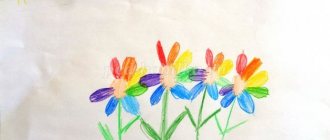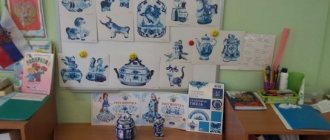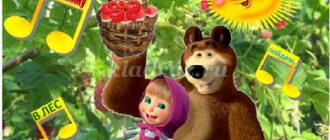Summary of GCD in the middle group: Houseplants
Summary of GCD in the middle group: The world of indoor plants
Author: Antonova Maria Vasilievna Description: I offer a summary of direct educational activities for children 4-5 years old. During the lesson, children's knowledge of indoor plants is consolidated. This material will be of interest to kindergarten teachers. Goal : expanding and consolidating children’s ideas about indoor plants; Objectives: - Clarify children’s ideas about the structure, needs of indoor plants, and their benefits to humans.
— Improve the ability to distinguish indoor plants by appearance and description. — Cultivate a caring attitude towards plants, kindness, and responsiveness. Preliminary work:
Caring for indoor plants in a corner of nature;
Examination of the folder “Indoor Plants”; Conversation “The World of Indoor Plants”; Didactic game “Which plant is gone?”; Didactic game “Where is the puppy hiding?” Materials: An envelope with a letter, indoor plants, pictures of indoor plants, flowers with a task, cards about the needs of plants, an empty envelope, a “magic bag” with plant care items, a matryoshka doll, an envelope with parts of a plant.
Progress of the GCD:
Children in the morning find an envelope at the entrance to the group. When all the children arrive, the teacher reads a letter to the children : “Hello, guys. Thumbelina is writing to you. I decided to turn to you for help. In our fairy-tale country of Elves there was a strong hurricane that carried away five magical flowers - helpers. If you find them and complete all the tasks written on the petals of these flowers, then our country will be, as before, bright and fabulously beautiful. Hope for your help. Thumbelina." Educator: - Well, guys, what are we going to do? (I lead the children to agree to help Thumbelina - find their flowers).
Children look for flowers in the group and find the first flower with the task.
Task 1 Educator: - Guys, guess the riddle: - They live next to us in pots with a tray, They love earth and water, air and sun. (indoor plants) Educator: - That's right, why do people need indoor plants? Children: - For air purification, beauty, comfort, health. Educator: - You can also play with indoor plants. Let's play with our plants and matryoshka. Game “Where is the nesting doll hiding?” (Children close their eyes, and the teacher hides a small nesting doll behind any indoor plant, and the children must guess and name the plant).
The children continue to look for flowers in the group.
Find the second flower with the task. Task 2 Game “Recognize the plant by description.” The teacher reads a card - a description of the plant, and the children guess and name the houseplant.
Children find the third flower with the task. Task 3 Game “Magic Bag”. Children recognize an object by touch and determine what it is for. (Water can, brush, cloth, spray bottle, loosening stick). Educator: - Guys, I suggest you relax. Physical education session At home , stand on your toes, pull your arms up;
And there are bridges,
bending forward, arms back, knees straight;
There are trees
straighten up, arms rounded above your head;
And the bushes,
sit down, stretch your arms forward;
And to everyone’s surprise
, stand up, arms to the sides, body turns,
Plants in the room [i]shoulders raised;
Without them, we can’t put our hands on our belts, turn our heads to the right and left;
Because we are friends!
spread your arms to the sides, clasp your body with your hands). Repeat 2-3 times.
The children continue to look for flowers and find a fourth flower with a task.
Task 4 Game “Assemble a plant from parts.” In the envelope of plant parts, the child makes up a plant from parts and explains which part of the plant is needed for what.
Children find the fifth flower with the task. Task 5 Game “What does a plant need to live and grow?” In the envelope there are cards - diagrams. Children arrange cards and explain what conditions are necessary for the growth of indoor plants.
Educator: - Guys, let's count the flowers we found. (children count flowers) Educator: So we fulfilled Thumbelina’s request. But what is their secret of these flowers? (children turn to the reverse side, on which the rules for caring for plants are written.) Educator: - Guys, I suggest you put the flowers in an envelope and send them to Thumbelina, in the land of the Elves. Children put flowers in an envelope and take the letter to the “post office.”
This lesson is the final one. During it, I clarified what knowledge the children received during the school year on the topic “Houseplants.” I was pleased with the results. I will continue to work on this topic in the senior group.
We recommend watching:
Abstract of GCD on cognitive development on the topic: Why does a plant need a root? Abstract of GCD for children of the senior group. Plant as a gift for mom Experimental activity in kindergarten. Senior preparatory group Summary of GCD in the senior group on the topic: Houseplant - Balsam
Similar articles:
Summary of educational activities on cognitive development for the middle group
Summary of GCD in the middle group on the topic: “My green friends”
GCD "Indoor plants" (middle group)
Well done! Guys, you already know that every plant has its own name. What names of indoor plants do you know? (Children name the plants and show them.)
2. Didactic game:
“Indoor and garden plants”
Educator:
Guys, what plants do you know besides indoor plants? (garden)
Can you tell them apart? On the table you see cards with pictures of indoor plants and garden flowers. They need to be distributed as follows: place indoor plants next to the flower pot, garden flowers - next to the flower bed.
3.Conversation about indoor plants:
Educator:
Children, look how many indoor plants there are in our group. What do you think these plants are for? (To make it beautiful.)
What else are indoor plants used for?
(Plants purify the air.)
It’s right that it should be beautiful—a person decorates his home with indoor plants. But they not only delight us with their beauty, but also cleanse the air of dust and dirt. Many indoor plants smell good.
Guys, what should you do to ensure that your indoor plant is always beautiful and doesn’t wilt? (care for a houseplant)
Let's tell you how we care for plants.
( children's answers)
4. Physical education:
Eat at home ( stand on your toes, stretch your arms up);
And there are bridges ( lean forward, arms back, knees straight
);
There are trees straighten up, ( round your arms above your head)
;
And the bushes, ( sit down, stretch your arms forward)
;
And to everyone’s surprise ( stand up, arms to the sides, body turns)
,
Plants in the room ( shoulders raised)
;
We can’t live without them ( hands on the belt, turning the head to the right and left)
;
Because we are friends! ( spread your arms to the sides, clasp your body with your arms
).
5. Game:
"What would happen if..."
-What would happen if the plant was placed in a dark place?
— What would happen if they forgot to water the plant?
— What would happen if you take care of the plant: water it, wash it, loosen the soil, feed it?
(Children's answers)
.
6.Planting a plant
Educator:
Let's plant geraniums with you. What does it take to plant a plant? (flower pot, soil, water for irrigation)
.
Children participate in planting the plant.
Educator:
Take a flower pot. What should we put in the pot first? (We fill the flower pot with soil and make a hole for the flower.)
After we've poured the soil, what's next?
(We plant the flower in the ground and sprinkle it.)
We have planted the plant, is there anything else that needs to be done? (Immediately after planting, the plant needs to be watered so that it grows better).
Reflection:
Complete the sentence: “I love taking care of indoor plants,
because..." (
children's answers)
Teacher:
Summary of the OD “Getting to know indoor plants” in the middle group
Olga Silkina
Summary of the OD “Getting to know indoor plants” in the middle group
Goal: expand children's knowledge about indoor plants . Objectives: introduce children to a new indoor plant - chlorophytum , noting its characteristic features, consolidate the ability to recognize familiar plants , name their parts (root, stem, leaf, flower)
Using a visual picture, develop speech and attention. Expand vocabulary: chlorophytum, heat, light, moisture, earth.
Cultivate a desire to care for indoor plants , treat them with love and tenderness. Preliminary work: looking at illustrations with indoor plants , reading poems and fairy tales about flowers, talking about plants . Materials: Houseplants , watering cans, aprons, oilcloths, Stepashka hare, rags, brushes, shovels and rakes for loosening Progress OD. V. Guys, today we will go to visit Stepashka. Let's say hello to him. Our Stepashka has indoor plants , but the problem is he doesn’t know what they are called and how to care for them. And we will help him! Q. Guys, the plants that stand here (children name
familiar plants ficus and violet ) Q. Guys, Stepashka has another
plant that is not familiar to us . Q. This plant is called chlorophytum, let's look at it in more detail. It has narrow hanging leaves of a light green color, a shortened stem and blooms with small flowers in the form of stars.
Q. Guys, look, are these plants similar or are they the same (children’s answers)
Q. Guys, how is ficus different from chlorophytum? The ficus has large, thick and rounded leaves, which allows it to purify the air. What is the difference between violet and chlorophytum? Violet leaves are round in shape, dark green in color, the leaves are pubescent, unlike chlorophytum (flowers of different colors if the plant blooms )
.
Q. Guys, now I suggest you go to the easel and carefully look at what our plants . Root, stem, leaves and flower if the plant blooms and the flower consists of petals, with the help of the root the plant is kept in the ground , leaves and flowers, if any, are located on the stem.
Physical education lesson A flower was sleeping and suddenly woke up (torso to the right, to the left)
Didn’t want to sleep anymore
(torso forward, backward)
He moved, stretched
(Arms up, stretched)
Soared up and flew
(Arms up, right, left)
Q. Guys, look what kind of objects are lying on the table. And what are they for (children's answers)
Q. That’s right, we need this to care for
indoor plants (our plants love light when the soil is well watered and loosened) Q. Now we put on aprons and turn into gardeners and gardeners and everyone begins their duties.
V. Well done guys! B. Didactic game “Assemble a plant from parts ”
Result Stepashka tells us “Thank you!”
, which helped to understand the name of
plants and their care . Let's say goodbye to Stepashka.



